

AAAS - Project 2061 - Math, Science, Technology and 'Habits of Mind' By Evelyn Porreca Vuko Special to The Washington Post Tuesday, September 29, 1998; Page D04 Newton’s in the kitchen putting crayons in the blender.

He’s inventing a new color. Success, he believes, hinges on adding just the right amount of bright red oil-based house paint. The Model>Principles of Learning: Summary. The latest gains in the field of brain research cast a new light upon the learning process, which impacts curriculum design, teacher preparation, and classroom practices (Bransford, Brown, & Cocking, 1999).
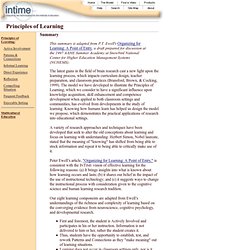
The model we have developed to illustrate the Principles of Learning, which we consider to have a significant influence upon knowledge acquisition, skill enhancement and competence development when applied to both classroom settings and communities, has evolved from developments in the study of learning. Knowing how humans learn has helped us design the model we propose, which demonstrates the practical applications of research into educational settings. MI Intro. ONE OF THE MOST COMPELLING, yet controversial new approaches to education reform is Multiple Intelligences Theory, or MI.

Conceived of by Howard Gardner of the Harvard Graduate School of Education and Harvard Project Zero, MI first swept the worlds of education, cognitive science and developmental psychology in 1983 with the publication of Gardner's treatise, Frames of Mind. In the decade since Frames, the work of Dr. Gardner and MI theory has shaken educators with a most fundamental question: What is intelligence? What is the the traditional view of intelligence? Brain-Based Learning. Technology and Multiple Intelligences. What are the multiple intelligences?
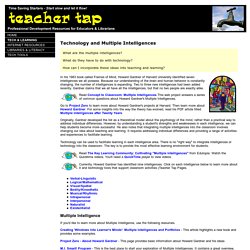
What do they have to do with technology? How can I incorporate these ideas into teaching and learning? Gardner's Multiple Intelligences. Howard Gardner of Harvard has identified seven distinct intelligences.
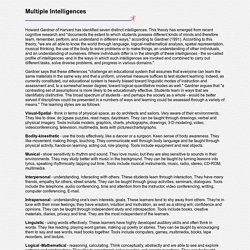
This theory has emerged from recent cognitive research and "documents the extent to which students possess different kinds of minds and therefore learn, remember, perform, and understand in different ways," according to Gardner (1991). According to this theory, "we are all able to know the world through language, logical-mathematical analysis, spatial representation, musical thinking, the use of the body to solve problems or to make things, an understanding of other individuals, and an understanding of ourselves. Meridian Article: Authentic Learning: A Practical Introduction & Guide for Implementation.
Learning Styles - Learning skills from MindTools.com. Understanding Learning Preferences Identifying your preferred style of learning can make gaining new knowledge and skills easier.

Have you ever tried to learn something fairly simple, yet failed to grasp the key ideas? Habits of Mind International. The Center for Effective Learning - Susan Kovalik & Associates, Inc. - Educational Professionals. MultimediaLearningEmpericalResults. HabitsOfMind. Constructivist Theory.
A major theme in the theoretical framework of Bruner is that learning is an active process in which learners construct new ideas or concepts based upon their current/past knowledge.
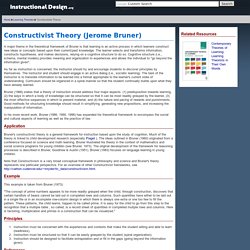
The learner selects and transforms information, constructs hypotheses, and makes decisions, relying on a cognitive structure to do so. Cognitive structure (i.e., schema, mental models) provides meaning and organization to experiences and allows the individual to "go beyond the information given". As far as instruction is concerned, the instructor should try and encourage students to discover principles by themselves. The instructor and student should engage in an active dialog (i.e., socratic learning). The task of the instructor is to translate information to be learned into a format appropriate to the learner's current state of understanding. Application Bruner's constructivist theory is a general framework for instruction based upon the study of cognition.
Constructivist Teaching and Learning Models. Constructivism is an approach to teaching and learning based on the premise that cognition (learning) is the result of "mental construction.
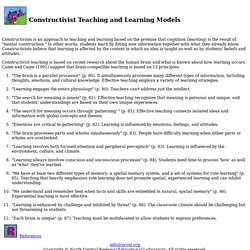
" In other words, students learn by fitting new information together with what they already know. Constructivists believe that learning is affected by the context in which an idea is taught as well as by students' beliefs and attitudes. Constructivist Learning Design Paper. Teachers and teacher educators make different meanings of constructivist learning theory.

At a recent retreat with facilitators of learning communities for teachers who were studying in a Masters of Education program, we were talking about our common reading of The Case for Constructivist Classrooms (Brooks & Brooks, 1993). We asked the ten facilitators to answer this question, "What is constructivism? " The results were interesting because all of their definitions were quite different and reflected their own understanding of the term and the text. This was a clear demonstration that what we read does not produce a single meaning but that understanding is constructed by the readers who bring prior knowledge and experience to the text and make their own meaning as they interact with the author's words. SEDL - SCIMAST Classroom Compass - Constructing Knowledge in the Classroom. Brain Connection » Powered by Posit Science - Your Brain Health Headquarters. Learning%20Theories%20and%20Information%20Literacy. Learner-Centered Teaching: Postsecondary Strategies That Promote "Thinking Like A Professional"
Find using OpenURL.
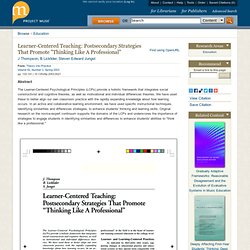
Teacher vs Learner centered instruction. Learner-centered teaching. Robert Glaser, Cognitive Psychologist and Expert on Student Testing, Dies at 91. The cause was complications of Alzheimer’s disease, said a spokesman for the Learning Research and Development Center, which Dr. Glaser helped found in 1963. Dr. Glaser was probably best known for promoting a kind of standardized test that became the norm for the federal government’s National Assessment of Educational Progress, the state-by-state evaluation commonly known as The Nation’s Report Card. The method, which he did not invent but championed, and coined as “criterion-referenced testing,” measured not just what students knew but how well they were learning. Rather than measuring students in comparison with one another, as I.Q. and other traditional standardized tests do, “criterion” tests were mainly designed to compare students’ results with their own previous test results.
It became the standard testing system for the periodic “Report Cards” exams in math, reading, history and science given to 4th, 8th and 12th graders throughout the country. Dr. Colleagues and family said Dr. Glaser educational theory. Situated Learning. Lave argues that learning as it normally occurs is a function of the activity, context and culture in which it occurs (i.e., it is situated). This contrasts with most classroom learning activities which involve knowledge which is abstract and out of context. Social interaction is a critical component of situated learning -- learners become involved in a "community of practice" which embodies certain beliefs and behaviors to be acquired.
As the beginner or newcomer moves from the periphery of this community to its center, they become more active and engaged within the culture and hence assume the role of expert or old-timer. Furthermore, situated learning is usually unintentional rather than deliberate. These ideas are what Lave & Wenger (1991) call the process of "legitimate peripheral participation. " Motivation theories psychology. Dan Pink: The puzzle of motivation. Motivation. Motivation to Learn: An Overview Citation: Huitt, W. (2011). Motivation to learn: An overview. Educational Psychology Interactive.
Valdosta, GA: Valdosta State University. Retrieved from Return to: | EdPsyc Interactive: Courses | Home | Translations: Russian Ukrainian | School Library Research (SLR) School Library Research (ISSN: 2165-1019) is the scholarly refereed research journal of the American Association of School Librarians. It is the successor to School Library Media Research (ISSN: 1523-4320) and School Library Media Quarterly Online.
The purpose of School Library Research is to promote and publish high quality original research concerning the management, implementation, and evaluation of school library programs. The journal will also emphasize research on instructional theory, teaching methods, and critical issues relevant to school libraries and school librarians. SLR seeks to distribute major research findings worldwide through both electronic publication and linkages to substantive documents on the Internet. The primary audience for SLR includes academic scholars, school librarians, instructional specialists and other educators who strive to provide a constructive learning environment for all students and teachers.
Joseph D. Novak. Senior Research Scientist Completing graduate studies at the University of Minnesota in 1958, Dr. Novak taught biology at Kansas State Teachers College at Emporia, 1957-59, and biology and teacher education courses at Purdue University, 1959-67. From 1967 to 1995, he was Professor of Education and Biological sciences at Cornell University where his research focused on human learning, educational studies and knowledge creation and representation. He has developed a theory of education to guide research and instruction, first published in 1977 and updated in 1998 and 2010. The Theory Underlying Concept Maps and How to Construct and Use Them.
Amazon. Making Concept Maps (Novak) Novak's cmap home. Looking at Learning ... Again. A Science Odyssey: People and Discoveries: B.F. Skinner. B.F. B.F. Skinner Foundation - Better Behavioral Science for a More Humane World. John B. Watson (American psychologist) John B. John Watson - Little Albert. A Science Odyssey: People and Discoveries: John Watson. John Watson1878 - 1958. What Is Behaviorism? How It Works and How It Influenced Psychology. A Science Odyssey: People and Discoveries: Ivan Pavlov. Ivan Pavlov. Ivan Petrovich Pavlov was born on September 14, 1849 at Ryazan, where his father, Peter Dmitrievich Pavlov, was a village priest. He was educated first at the church school in Ryazan and then at the theological seminary there.
Inspired by the progressive ideas which D. I. Pisarev, the most eminent of the Russian literary critics of the 1860's and I. M. Pavlov became passionately absorbed with physiology, which in fact was to remain of such fundamental importance to him throughout his life. Thorndike-edward-1. Connectionism. From Psychology: An Introduction by Russ Dewey. Edward L. Thorndike (American psychologist) Human Intelligence: biographical profiles, current controversies, resources for teachers.
Pew Research Center's Internet and American Life Project. Reading Online. Welcome to the American Sports Institute. Flow States and Student Engagement in the Classroom David Shernoff, Ph.D. Wisconsin Center for Education Research University of Wisconsin - Madison Statement to the California State Assembly Education Committee State Capitol • February 27, 2002.
Reading Online. Motivational theory research. McClelland's Human Motivation Theory - Team Management Training From MindTools.com. Motivational theory research. SOCIAL LEARNING THEORY of Albert Bandura, Chapter 31. Social Learning Theory. Social learning theory. Learning theory. Interactive Techniques.doc. Teaching-for-meaningful-learning.pdf. Making Thinking Visible. Project-Based Learning Professional Development Guide. Building a Bridge to Knowledge for Every Child: How It Could Work. How can research on the brain inform education? Brain-Based Research Prompts Innovative Teaching Techniques in the Classroom.
Great Performances . Educational Resources . Howard Gardner's Multiple Intelligences Theory . Overview. Can Technology Exploit the Many Ways of Knowing by Howard Gardner. Learning Theories.